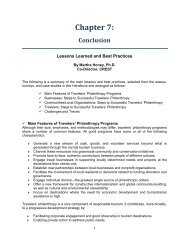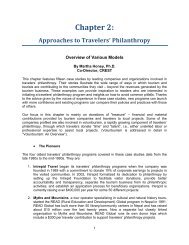Travelers' Philanthropy Handbook - Center for Responsible Travel
Travelers' Philanthropy Handbook - Center for Responsible Travel
Travelers' Philanthropy Handbook - Center for Responsible Travel
Create successful ePaper yourself
Turn your PDF publications into a flip-book with our unique Google optimized e-Paper software.
efreshments, etc. This should be negotiated be<strong>for</strong>ehand and may be either a fixedamount per visitor or lump sum <strong>for</strong> a group.b. Offer in<strong>for</strong>mation to travelers and an opportunity to contribute during or after theirvisit. Experience will help you determine when is most appropriate to make “the ask”– or “the offer”.c. Offer multiple ways to accept donations, including on the spot, through the tourcompany, via a local foundation, online, or with a follow-up mailing.d. Explain to travelers how their donations will be used, with tangible examples.e. <strong>Travel</strong> companies can provide contributions in addition to donations from travelersthrough corporate and/or staff donations, incentives like matching visitor donations,offering travel vouchers to visitors who make larger donations, and facilitating taxdeductions <strong>for</strong> contributions.f. <strong>Travel</strong>ers are more willing to contribute if they have confidence in the tourismcompany and the company has a well-established relationship with yourorganization.g. Prepare a “wish list” of any material donations your organization would like travelersand volunteers to bring, as well as a list of things that should not be given.h. Make sure donations and supplies are given to a person in charge and notdistributed by the visitors.5. Determine if Volunteers Can Address Real Needs, and Carefully Weigh the Prosand Cons of Managing Thema. Volunteers take staff time and organizational resources to host and manage. Clearlydesignate a person(s) within your organization or project overseeing volunteertourism (“voluntourism”) and managing their program.b. Voluntourism activities can run from a couple of hours to weeks, months or even oneor more years. Carefully consider the length of stay sufficient to accomplish thespecified tasks and produce sufficient benefits to your organization or project.c. Programs must be managed with the goal of creating financial sustainability.Organizations often require volunteers to cover their own expenses; some chargethe volunteers <strong>for</strong> the experience. Foster commitments by volunteers to donate afterthey leave the project and become a channel <strong>for</strong> ongoing giving from the volunteer,friends, and family.d. Volunteers can be important teachers, transferring skills to local people and takingtheir enthusiasm and deeper understanding back to help teach others.e. Volunteer projects must be selected by and implemented with the local community ororganization.f. Volunteers should not take jobs that local people could be hired to do.g. If you decide to use volunteers, prepare a written policy outlining <strong>for</strong> perspectivevolunteers the necessary skills, length of stay, financial obligations, and otherrequirements.h. Volunteers must be educated about what is culturally appropriate so they will avoidactions – even well intended ones -- that can have negative impacts. This shouldbegin be<strong>for</strong>e the volunteer arrives and can be a shared responsibility with the tourismcompany or other recruiting agency.i. Carefully consider the appropriateness and benefits of particular tasks.o Projects involving vulnerable populations – including orphans, school children,and HIV/AIDS patients – are especially sensitive.o Short term volunteer postings with child welfare projects should be avoidedbecause children need stability.213















